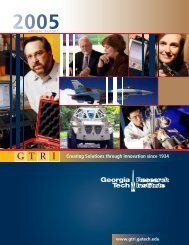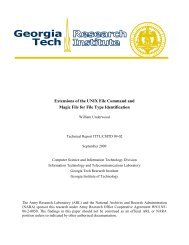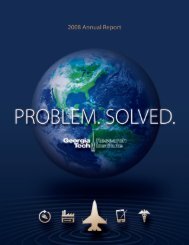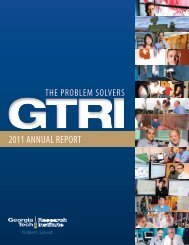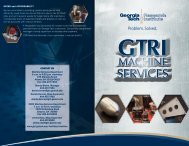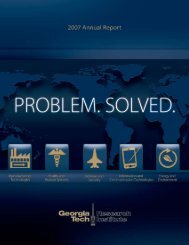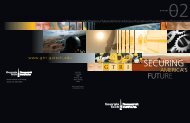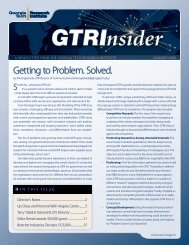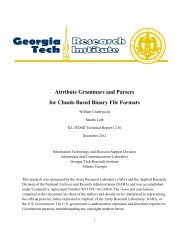Cultural Influences Associated with Adversarial Recruitment
Cultural Influences Associated with Adversarial Recruitment
Cultural Influences Associated with Adversarial Recruitment
You also want an ePaper? Increase the reach of your titles
YUMPU automatically turns print PDFs into web optimized ePapers that Google loves.
L. G. Weiss, E. Whitaker, E. Briscoe, E. Trewhitt, R. Gonzalez, “<strong>Cultural</strong><strong>Influences</strong> <strong>Associated</strong> <strong>with</strong> <strong>Adversarial</strong> <strong>Recruitment</strong>.” Advances in Cross-<strong>Cultural</strong>Decision Making. (2010). Schmorrow, D. and Nicholson, D., Eds. CRC Press. 217-228.<strong>Cultural</strong> <strong>Influences</strong><strong>Associated</strong> <strong>with</strong> <strong>Adversarial</strong><strong>Recruitment</strong>Lora Weiss, Elizabeth Whitaker, Erica Briscoe,Ethan Trewhitt, and Margarita GonzalezGeorgia Tech Research InstituteGeorgia Institute of TechnologyAtlanta, GA 30332, USAABSTRACTThe recruitment of individuals to participate in adverse behaviors often involvestactics that exploit cultural underpinnings to help persuade the individual toparticipate in the activity. The exploitation of aspects that culturally resonate <strong>with</strong>the individual may be what makes the final determination for the individual to „tipto the other side‟. <strong>Cultural</strong> aspects include beliefs, attitudes, and values that anindividual acquires when being raised in a particular culture, yet limited researchhas been conducted in methods to analytically assess how cross-cultural influencesmay affect the recruitment process. Cross-cultural influences affect interactionsbetween members of disparate cultural groups. As an example, consider members ofAfghanistan‟s Taliban, who are predominantly Pashtun, trying to recruit from asubgroup of Pakistanis who are Punjabi. This chapter presents a modeling approachfor capturing some of these cultural aspects and enabling analysis to support a
Chapter title 5SYSTEM DYNAMICS MODELSSystem dynamics models are executable models that represent the dynamicbehavior of complex systems over time (Sterman 2000). They use stocks and flowsto represent system elements and relationships. Stocks represent inventories ofaccumulated entities (e.g., IEDs, people), while flows represent how entities movebetween stocks. Figure 3 presents a simplified schematic of a core IED perpetrationmodel, <strong>with</strong> three focus areas: Materials and Supplies, IED Inventory, and ActiveInsurgents. Stocks are indicated <strong>with</strong> boxes. Flows are indicated <strong>with</strong> double-linedarrows. Clouds take the place of stocks and represent the world outside the scope ofthe model. The third line is of utmost interest in this chapter and is subsequentlydetails; however, it is presented <strong>with</strong>in the larger system context to understand thatpeople‟s actions are coupled <strong>with</strong> materials and events. The core model is then usedas a foundation from which submodels or model expansions are incorporated, and itencompasses many aspects of the larger terrorism and recruitment domain.Figure 3. Simplified core model <strong>with</strong> three focus areas.Materials and Supplies Focus Area. Figure 3 shows a single stock, Materialsand Supplies, which represents the inventory of materials and supplies available toinsurgent groups. The input flow, Gathering, represents actions that cause materialsto accumulate. The output flow, Consumption, represents material used during IEDconstruction. More details are behind this model (Weiss 2009), but for a recruitmentexposition, it is kept simple. Other behavioral aspects may include gathering illicititems that cannot be readily purchased or financial backers of base materials(National Research Council 2008).IED Process Focus Area. The IED process is presented in the center of Figure 3and expanded in Figure 4. It contains five stocks representing how IEDs that movethrough phases from being constructed to emplaced to detonated. In practice, theprocess is varied, but this model is a generalized representation that SMEs felt wasreflective of the process. Stepping through Figure 4, a typical IED is constructedeither for a particular attack or stored for future use. Once it is constructed it movesinto inventory, such as a warehouse, or a less conventional storage approach (e.g.,
6 Book Title – do not write here!distributed throughout the community). An IED may also be held by an individual<strong>with</strong> little knowledge of the item‟s actual purpose. It then moves from inventory tobeing emplaced and eventually triggered. At any point, counter-IED methods maydestroy. This disruption detours the IED flow and deposits it in the Disrupted IEDsstock. Insurgent motivations for participating in this process are represented in theIED Motivation submodel. These motivations are included as one of manysubmodels that allow influences to be assessed.Figure 4. IED Process model components.
8 Book Title – do not write here!Figure 5. Insurgent personnel model components.Radicalization and Deradicalization Submodel. Radicalization is defined inmany ways and means different levels of involvement to different people. For thisexposition, it represents the transition of a person from <strong>with</strong>in the GeneralPopulation to the Grey Population. This occurs when a previously neutral personhas taken a position of sympathy for insurgent beliefs. Insurgent groups achieve thisthrough various means, such as spreading broad propaganda supporting their goals,by using community roles as an influence, etc. When a person holds a positive viewof the insurgents‟ goals and tactics, that person is vulnerable for recruitment. Thisstage has less outward manifestations and may exist to varying degrees. It mayoccur as an overt decision by the participant or it may be a gradual process in whicha person becomes more sympathetic to an insurgent group.Some of the known factors that contribute to this conversion include: poverty,ignorance, injustice, and bad governance (Shemella 2009). The range of factors canbe roughly categorized as external and internal. Internal factors include variablessuch as strength of personal ideology, the increase of self-esteem that results fromjoining a cause, and the resentment that is felt toward such matters as militarypresence and the loss of loved ones in military engagements (Gerwehr & Daly2007). External factors include the influence felt by both pro- and anti-insurgencyreligious leaders, family and peer pressure. More general factors that affectindividuals‟ behaviors can be grouped into four main categories: (i) Camusvariables include those related to the morality of a population (e.g., is the populationparticularly violent or does common religious doctrine condemn violence), (ii)Dewey variables consist of social aspects, such as freedom of speech, (iii) Smithvariables represent economic variables <strong>with</strong>in the society (e.g., GDP), and (iv)Maslow variables cover quality of life factors, such as the availability of water andmedical care. The collection of these factors can be combined using an influencediagram (see Figure 6), which then supports assessing the broad influence onradicalization. This grouping of factors is based on Bartolomei, et al. (Bartolomei etal. 2004). Deradicalization occurs when the attitudes of an individual are moderatedfrom the radical views to the more mainstream views of the general population.
10 Book Title – do not write here!that their attitude might become even more steadfast in the face of these types ofpersuasive materials (Cragin & Gerwehr 2005; Tess & Conlee 1975).Figure 7. Insurgent recruitment and disengagement submodelCONCLUSIONSThis chapter focuses on component modeling of socio-cultural and cross-culturalbehaviors related to terrorist recruitment and the motivation to engage in adversarialbehaviors. The approach combines computational and social science research tounderstand activities and influences <strong>with</strong>in a population. The benefit is that,although integrated models will not precisely predict who will become recruited,they can provide insight into the relative importance of factors and influences, e.g.,it may be perceived that the best intervention point is to influence the GeneralPopulation before they are radicalized, but if a large part of the population isinherently radicalized, there may not be much benefit in working <strong>with</strong> the generalpopulation. A more effective approach may be to address the flow from the GreyPopulation to the further radicalized stage of Active Insurgent. This modelingconstruct may also expose previously unconsidered aspects of the problem so thatinsight is gained on issues that may not otherwise be considered. The integratedcomponents then provide a construct for analysis of recruitment deterrents andpotential intervention points associated <strong>with</strong> adversarial behavior.REFERENCESBartolomei, J., Casebeer, W., & Thomas, T. (2004). Modeling Violent Non-StateActors: A Summary of Concepts and Methods. United States Air Force Academy,Institute for Information Technology Applications, Colorado.
Chapter title 11Bellerby, R. (2009) How Crusaders Were Recruited in Medieval Times, available athttp://highmiddleages.suite101.com/article.cfm/how_crusaders_were_recruited_in_medieval_timesBergen, P. (2007). War of Error. The New Republic. Available athttp://www.newamerica.net/publications/articles/2007/war_error_6154Clark, M. (2005). “Observations on Local Insurgents and Foreign Fighters in Iraq:an Interview <strong>with</strong> Mark Edmond Clark.” Interviewed by Columbia InternationalAffairs Online. Columbia International Affairs Online.Cragin, K. and Gerwehr, S. (2005). Dissuading Terror. Strategic Influence and theStruggle Against Terrorism. RAND Monographs.Crenshaw, M. (2000). The Psychology of Terrorism: An Agenda for the 21 stCentury. Political Psychology, 21(2), 405-420.Gerwehr, S. & Daly, S. (2006). Al-Qaida: Terrorist Selection and <strong>Recruitment</strong>. InD. Kamien (Ed.) The McGraw-Hill Homeland Security Handbook. McGraw-Hill.Grunow, Carl D. 2006. “Advising Iraqis: Building the Iraqi Army,” MilitaryReview. Available at: www.army.mil/professionalwriting/volumes/volume4/october_2006/10_06_1_pf.htmlHofstede, Geert. 2009. <strong>Cultural</strong> Dimensions. Available at: http://www.geerthofstede.com/Kershaw, S. (2010). The Terrorist Mind: An Update. The New York Times.National Research Council. (2008). Disrupting Improvised Explosive Device TerrorCampaigns. Washington, D.C.: National Academies Press.Shemella, P. (2009) Reducing Ideological Support for Terrorism. Strategic Insights.Vol III, Issue 2. Naval Postgraduate School. Monterey, California.Sterman, J. (2000). Business Dynamics: Systems Thinking and Modeling for aComplex World (1st ed.). Boston: McGraw-Hill/Irwin.Tess & Conleee. (1975). Some effects of time and thought on attitude polarization.Journal of Personality and Social Psychology, vol 31.Weiss, L., Whitaker, E., Briscoe, E., Trewhitt, E., (2009). Modeling BehavioralActivities Related to Deploying IEDs in Iraq. Georgia Tech Research Institute,Technical Report #ATAS-D5757-2009-01, Atlanta, GA.Wilson, James S. 2008. “Iraqi Sunnis‟ <strong>Cultural</strong> Receptivity of Islamic Extremists‟Beliefs.” Maxwell Air Force Base. Available at:https://www.afresearch.org/skins/rims/.../display.aspxWunderle W. D. (2006). Through the Lens of <strong>Cultural</strong> Awareness: A Primer of USArmed Forces Deploying to Arab and Middle Eastern Countries. Combat StudiesInstitute Press.Zacharias, G., MacMillan, J., & Van Hemel, S. (Eds.). (2008). Behavioral Modelingand Simulation: from Individuals to Societies. National Research Council.




